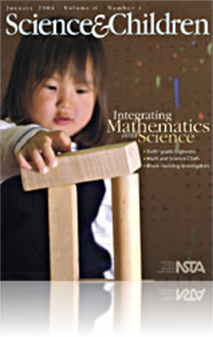All Science and Children resources
Journal Article
Professional Development for You
No Child Left Behind’s emphasis on accountability and demands for a quality teacher in every classroom has spawned a cottage industry of providers of professional development. How can educators begin to sort through them all to find the right choic...
Journal Article
Moderation, or the interactive analysis of student work by small groups of teachers, can help to qualify student understanding and increase teacher sensitivity to student progress with difficult concepts. This article describes how the process of mod...
Journal Article
Science 101? What Causes Rainbows?
If you look at a rain cloud with the Sun behind your back, the sunlight and water drops may interact just right, revealing the familiar arc of red, orange, yellow, green, blue, indigo, and violet. Many of us have been pleasantly surprised to see a r...
Journal Article
Teaching Through Trade Books: Water Wherever
Whether rain, sleet, or snow, February weather across the country provides students with opportunities to observe the many different ways the water cycle affects our daily lives. This month's trade books that focus on the water cycle include The Snow...
Journal Article
AIM for Professional Development
Instructional materials help guide both what and how teachers teach and what and how students learn. Most educators, however, are not aware that the selection of instructional materials can serve as energizing, engaging professional development. This...
Journal Article
Home Connections: Thumbs Are Handy Digits
Hold your hand out in front of you and look a it carefully. The human hand is made up of four fingers and one thumb. Have you ever thought about how much you use your thumb? This month’s Home Connections activity helps students understand the imp...
Journal Article
Teacher Quality: From Policy to Practice
The No Child Left Behind act requires schools to have “qualified teachers” in every classroom by the 2005-2006 school year. This mandate has made professional development a priority. This article defines quality professional development, describe...
Journal Article
Two university educators and a sixth-grade teacher collaborated to create and implement a five-day engineering unit that incorporated both mathematics and science concepts and hands-on learning. In this series of engineering activities, students tes...
Journal Article
Seeking to revitalize a unit on rocks, sand, and soil for first-graders, the authors created new hands-on lessons. These included testing the hardness of rocks, making models of the Earth, and sorting rocks. As a culminating activity, students partic...
Journal Article
In this month's section we explore the integration of math into the science curriculum. Meaningful math and science integration can also help teachers identify specific skills and standards that support their science and mathematics curricula. ...
Journal Article
Home Connections: Counting Populations
This activity, designed for students to do at home, introduces the concept of population sampling. Students scatter pasta on a grid and count the number of pieces in three sample boxes....
Journal Article
Science 101: How Do Microscopes Work?
Microscopes allow scientists to examine everyday objects in extraordinary ways. They provide high-resolution images that show objects in fine detail. This articles includes details on how microscopes work and how they enhance the scientific process...



